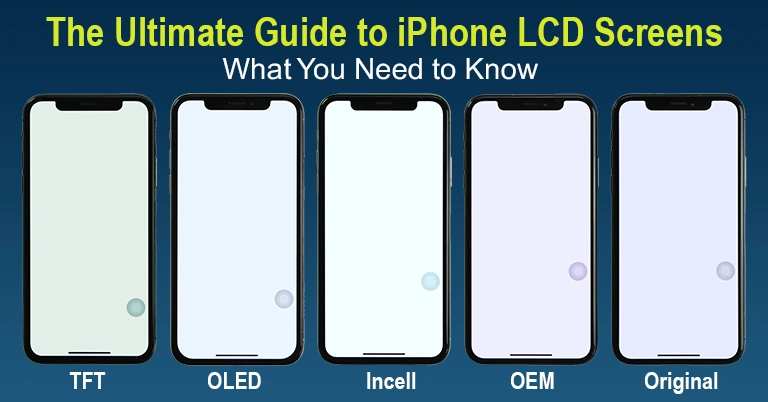
When it comes to smartphones, the display is one of the most critical components that directly influences user experience. For Apple’s iPhone, LCD (Liquid Crystal Display) screens have been a staple in many models, particularly before the transition to OLED (Organic Light Emitting Diode) technology. This guide will delve into how iPhone LCD screens work, their components, and how they compare with OLED screens and Incell LCDs.
Understanding LCD Technology
How LCD Screens Work
LCD technology relies on liquid crystals sandwiched between two layers of glass or plastic. These crystals do not emit light by themselves; instead, they manipulate light from a backlight source. When an electric current passes through the liquid crystals, they align in such a way that allows varying amounts of light to pass through each pixel. This process creates images by controlling the intensity and color of light that reaches the viewer’s eyes. The typical structure of an LCD screen includes:
- Backlight: The source of illumination for the display.
- Polarizers: Two polarizing filters that control the light entering and exiting the liquid crystal layer.
- Liquid Crystals: The core component that modulates light based on electrical signals.
- Color Filters: These create red, green, and blue subpixels that combine to produce full-color images.
Components of iPhone LCD Screens
iPhone LCD screens consist of several key components:
- Backlight Unit: Most iPhones use LED backlighting which provides bright and uniform illumination across the screen.
- Glass Layer: This is the outermost layer that protects the internal components while allowing touch sensitivity.
- Touch Sensor: Integrated into or just beneath the glass layer, this sensor detects touch inputs from users.
- Driver Circuitry: This electronic component controls how pixels are illuminated based on input from the device’s processor.
Performance Characteristics
Brightness and Color Accuracy
One of the notable features of traditional LCDs is their ability to produce bright displays with good color accuracy. However, they often struggle with deep blacks because they rely on a constant backlight rather than emitting their own light like OLEDs do. This can lead to less contrast compared to OLED displays.
Viewing Angles
LCD screens generally have decent viewing angles but can suffer from color distortion when viewed from extreme angles. In contrast, OLED displays maintain consistent colors regardless of viewing angle due to their self-emissive nature.
Power Consumption
LCDs typically consume more power when displaying darker images since they rely on a backlight that remains constantly lit regardless of what is being displayed. Conversely, OLED screens can turn off individual pixels completely when displaying black content, resulting in lower power consumption during dark scenes.
Comparing LCD With OLED Screens
Advantages of LCD Over OLED
- Cost-Effectiveness: Generally cheaper to manufacture than OLED panels.
- Longevity: Less susceptible to burn-in issues compared to OLED displays where static images can leave permanent marks over time.
- Brightness Levels: Can achieve higher brightness levels in certain conditions due to their backlighting technology.
Disadvantages Compared To OLED
- Contrast Ratio: Lower contrast ratios due to inability to produce true blacks.
- Color Range: Limited color range compared to high-end OLED displays which can show deeper colors and more vibrant images.
- Thickness and Flexibility: Typically thicker than OLED panels which can be made thinner and more flexible for innovative designs.
Incell vs Traditional LCDs
Incell technology represents an advancement in LCD design where touch sensors are integrated directly into the display panel rather than being placed atop it as in traditional designs. This integration leads to several benefits:
- Thinner Displays: By combining layers, Incell technology allows for slimmer devices without sacrificing performance.
- Improved Touch Sensitivity: Direct integration enhances responsiveness and reduces latency during touch interactions.
- Better Image Quality: With fewer layers between the viewer and pixels, Incell displays often provide improved clarity and brightness.
However, traditional LCDs still hold advantages in terms of cost-effectiveness for mass production and repairability since replacement parts are widely available.
Conclusion
Understanding iPhone LCD screen replacement involves recognizing their fundamental workings—how liquid crystals manipulate light—and appreciating their role within Apple’s ecosystem alongside newer technologies like OLED and Incell displays. While advancements continue in display technology, traditional LCDs remain relevant due to their reliability, cost-effectiveness, and solid performance characteristics for everyday use.
As consumers become increasingly aware of these differences, it’s essential for them to make informed choices based on their specific needs—whether prioritizing cost efficiency or seeking cutting-edge display quality.
In summary, while both LCDs and newer technologies like OLED have their unique strengths and weaknesses, understanding these elements helps users appreciate what goes into making their devices functional and visually appealing.
